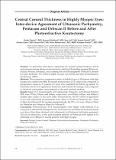| dc.contributor.author | Nassiri, Nader | en_US |
| dc.contributor.author | Sheibani, Kourosh | en_US |
| dc.contributor.author | Safi, Sare | en_US |
| dc.contributor.author | Nassiri, Saman | en_US |
| dc.contributor.author | Ziaee, Alireza | en_US |
| dc.contributor.author | Haji, Farnaz | en_US |
| dc.contributor.author | Mehravaran, Shiva | en_US |
| dc.contributor.author | Nassiri, Nariman | en_US |
| dc.date.accessioned | 2014-07-07T17:03:57Z | |
| dc.date.issued | 2014 | en_US |
| dc.identifier.citation | Nassiri, Nader, Kourosh Sheibani, Sare Safi, Saman Nassiri, Alireza Ziaee, Farnaz Haji, Shiva Mehravaran, and Nariman Nassiri. 2014. “Central Corneal Thickness in Highly Myopic Eyes: Inter-device Agreement of Ultrasonic Pachymetry, Pentacam and Orbscan II Before and After Photorefractive Keratectomy.” Journal of Ophthalmic & Vision Research 9 (1): 14-21. | en |
| dc.identifier.issn | 2008-2010 | en |
| dc.identifier.uri | http://nrs.harvard.edu/urn-3:HUL.InstRepos:12406757 | |
| dc.description.abstract | Purpose To determine inter-device agreement for central corneal thickness (CCT) measurement among ultrasound pachymetry, rotating Scheimpflug imaging (Pentacam, Oculus, Wetzlar, Germany), and scanning slit corneal topography (Orbscan II, Bausch & Lomb, Rochester, NY, USA) in highly myopic eyes before and after photorefractive keratectomy (PRK). Methods: This prospective comparative study included 61 eyes of 32 patients with high myopia who underwent PRK. Six month postoperative CCT values were compared to preoperative values in 27 patients (51 eyes) who completed the follow up period. To determine the level of agreement, Pentacam and Orbscan II readings were compared to ultrasonic pachymetry measurements as the gold standard method. Results: Mean CCT measurements with ultrasound, Pentacam, and Orbscan II before PRK were 557µm, 556µm, and 564µm, respectively; and 451µm, 447µm, and 438µm 6 months after surgery in the same order. Preoperatively, the 95% limits of agreement (LoA) with ultrasound measurements were -20μm to 17μm for Pentacam and -21μm to 33μm for Orbscan II. Six months postoperatively, the 95% LoA were -30μm to 23μm for Pentacam and -69μm to 43μm for Orbscan II. Conclusion: Preoperatively, CCT measurements were higher with Orbscan II as compared to ultrasound. Postoperatively, both Pentacam and Orbscan II measurements were lower than those obtained with ultrasound, but Pentacam had better agreement. The use of ultrasound, as the gold standard method, or Pentacam both appear to be preferable over Orbscan II among patients with high myopia. | en |
| dc.language.iso | en_US | en |
| dc.publisher | Ophthalmic Research Center | en |
| dc.relation.hasversion | http://www.ncbi.nlm.nih.gov/pmc/articles/PMC4074469/pdf/ | en |
| dash.license | LAA | en_US |
| dc.subject | Myopia | en |
| dc.subject | Central Corneal Thickness | en |
| dc.subject | Photorefractive Keratectomy | en |
| dc.subject | Ultrasound Pachymetry Pentacam | en |
| dc.subject | Orbscan II | en |
| dc.title | Central Corneal Thickness in Highly Myopic Eyes: Inter-device Agreement of Ultrasonic Pachymetry, Pentacam and Orbscan II Before and After Photorefractive Keratectomy | en |
| dc.type | Journal Article | en_US |
| dc.description.version | Version of Record | en |
| dc.relation.journal | Journal of Ophthalmic & Vision Research | en |
| dc.date.available | 2014-07-07T17:03:57Z | |
| dash.authorsordered | false | |


